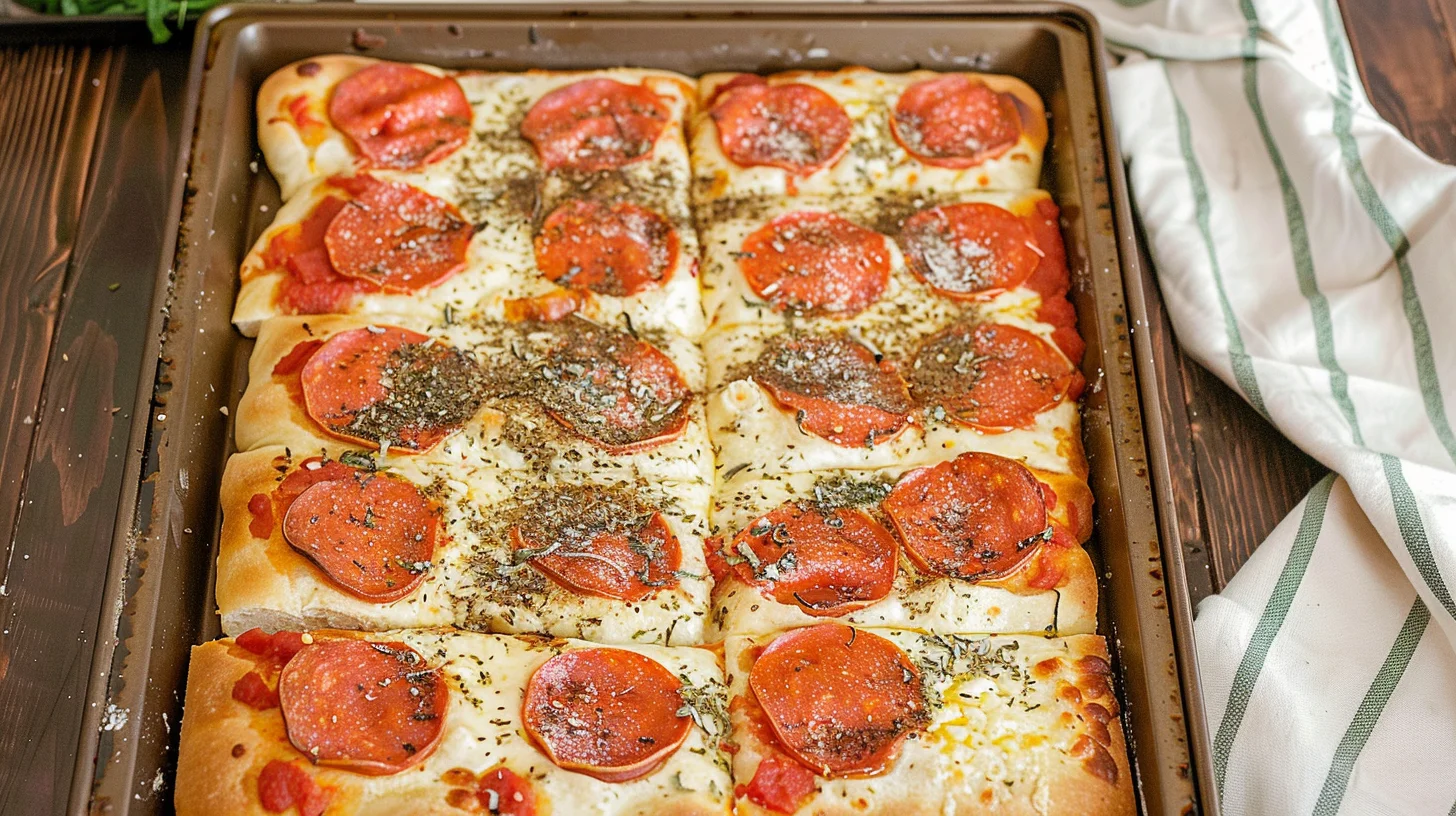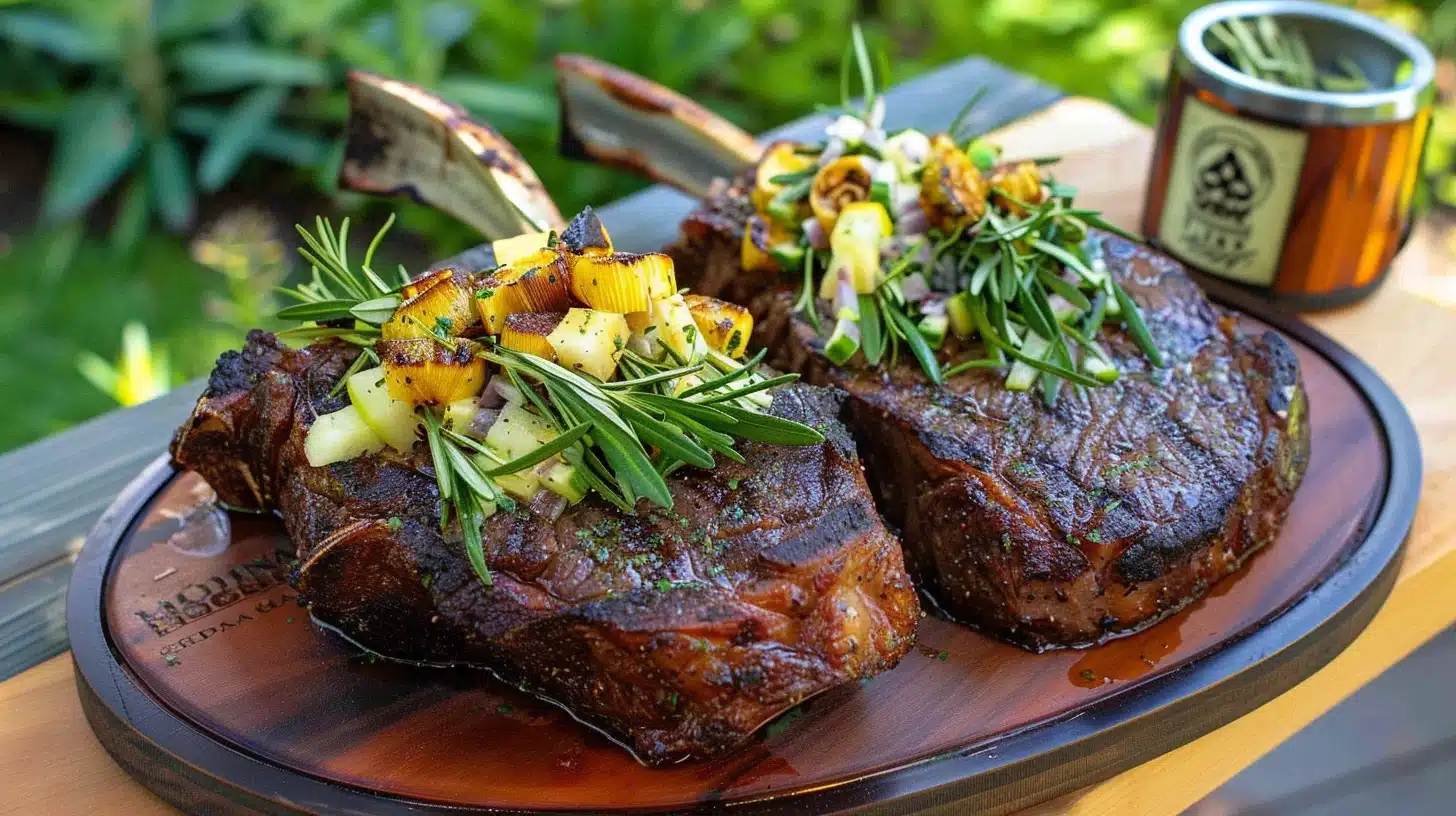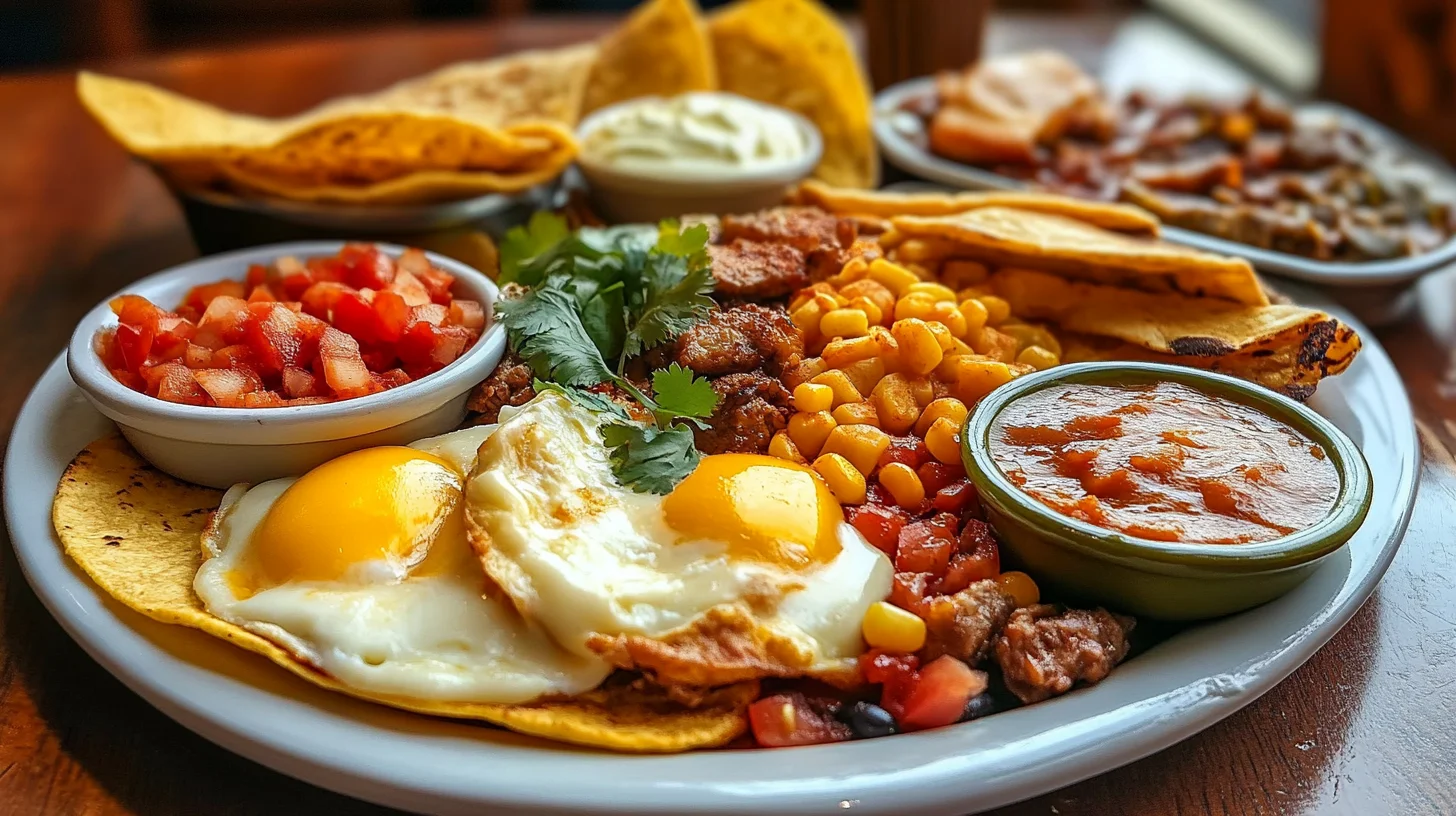There’s something special about baking your own bread at home. The aroma that fills the kitchen, the joy of watching it rise, and the satisfaction of slicing into a warm, freshly baked loaf – it’s an experience like no other. For me, making focaccia using pizza dough has become a favorite pastime.
This easy focaccia recipe is not only delicious but also incredibly simple. With just a few ingredients and some basic kitchen tools, you can create a mouth-watering homemade focaccia that’s perfect for snacking, as a side dish, or even as a base for sandwiches.
Key Takeaways
- Simple recipe using pizza dough
- Delicious homemade focaccia
- Perfect for snacking or as a side dish
- Easy to make with basic kitchen tools
- Versatile for various uses
The Magic of Pizza Dough Focaccia
The versatility of pizza dough makes it perfect for creating delicious focaccia. This simple yet ingenious approach to baking has revolutionized my kitchen, allowing me to produce mouth-watering bread with minimal extra effort.
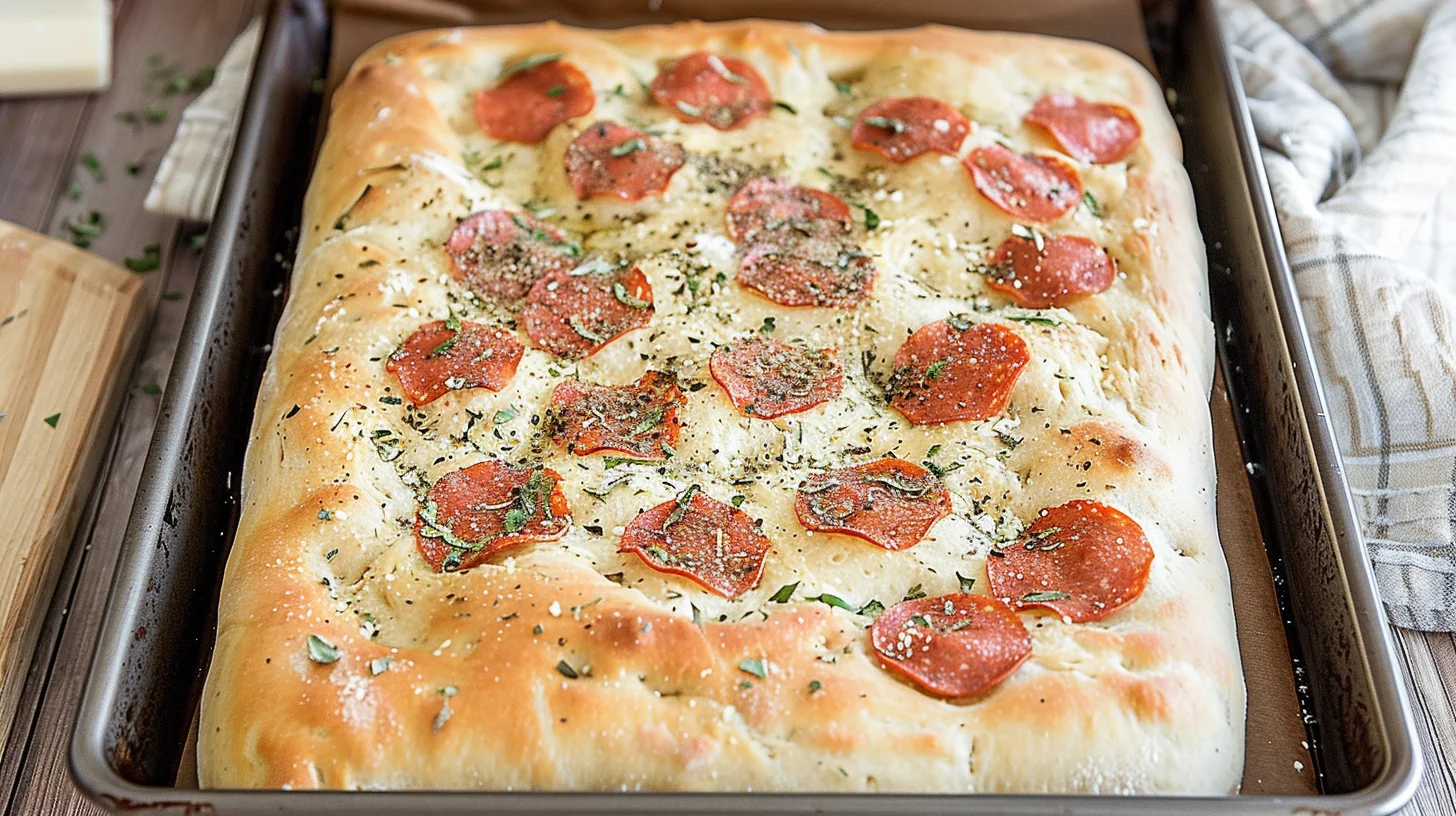
Why Pizza Dough Makes Great Focaccia
Using pizza dough to make focaccia is a stroke of genius because it leverages the same ingredients and techniques, simplifying the baking process. The resulting focaccia is soft, airy, and full of flavor, making it perfect for dipping in olive oil or sauces.
The key lies in the dough’s yeast fermentation process, which gives focaccia its characteristic texture and taste. By utilizing pizza dough, you’re essentially killing two birds with one stone, as you can create both delicious pizzas and focaccia with the same base.
My Journey with Pizza Dough Focaccia
My journey with pizza dough focaccia began when I was experimenting with different ways to use leftover pizza dough. I was amazed at how easily it transformed into a crusty, cheesy, and utterly delicious focaccia. Since then, I’ve made it a staple in my baking repertoire.
I’ve found that using pizza dough for focaccia not only saves time but also reduces food waste, making it a practical and environmentally friendly choice. Whether you’re a seasoned baker or a beginner, this method is sure to yield impressive results.
Pizza Dough vs. Traditional Focaccia Dough: What’s the Difference?
Understanding the nuances between pizza dough and focaccia dough is crucial for achieving the perfect bake. While both share some similarities, their differences significantly impact the final product.
Similarities in Ingredients and Texture
Both pizza dough and focaccia dough are made from basic ingredients: flour, water, yeast, salt, and sometimes oil. Their textures are also somewhat similar, as both can have a chewy interior and a crispy exterior when baked correctly. However, the proportions of these ingredients and the processing methods can vary, leading to distinct outcomes.
Key Differences to Be Aware Of
The main differences lie in hydration levels, oil content, and fermentation time. Let’s break down each of these factors to understand their impact.
Hydration Levels
Focaccia dough typically has a higher hydration level than pizza dough, making it softer and more prone to dimpling. This higher water content contributes to its characteristic texture.
Oil Content
Focaccia dough often includes more oil than pizza dough, which enhances its flavor and texture. The oil helps create the signature softness and tenderness of focaccia.
Fermentation Time
The fermentation time can vary between pizza and focaccia dough. Focaccia often benefits from a longer fermentation, which develops its flavor and texture more fully.
| Dough Type | Hydration Level | Oil Content | Fermentation Time |
| Pizza Dough | Lower | Less | Variable |
| Focaccia Dough | Higher | More | Longer |
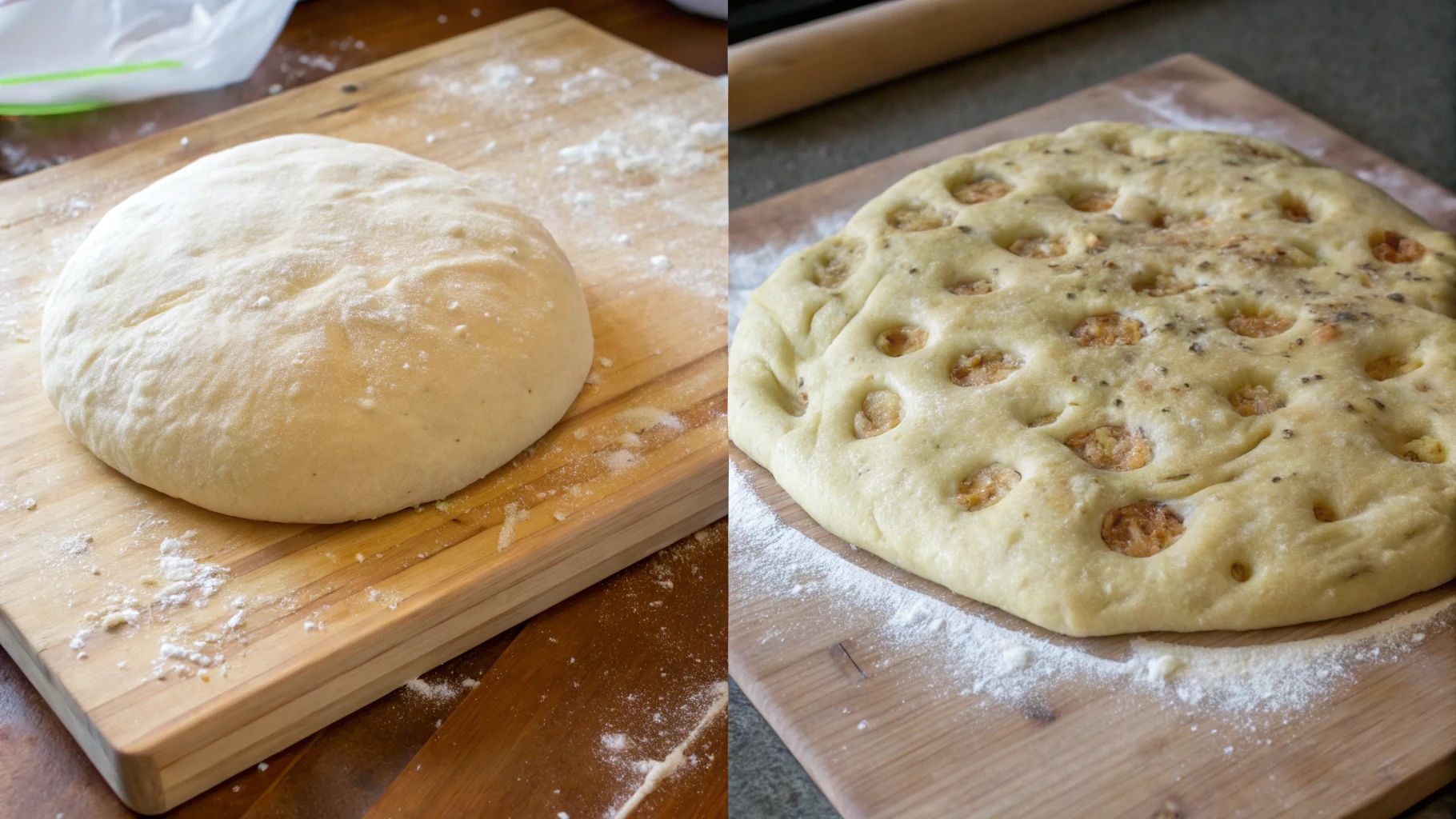
Essential Ingredients for Perfect Pizza Dough Focaccia
The foundation of a delicious homemade focaccia lies in its simple yet critical ingredients. To make a perfect pizza dough focaccia, you’ll need to focus on a few key components that work together to create its characteristic flavor and texture.
Basic Ingredients List
The basic ingredients for pizza dough focaccia include flour, water, yeast, salt, and olive oil. Each of these plays a crucial role in the final product. Flour provides structure, water hydrates the dough, yeast helps it rise, salt enhances flavor, and olive oil adds richness and tenderness.
Choosing the Right Flour
Selecting the appropriate flour is vital for achieving the desired texture and flavor. The type of flour you choose can significantly impact your focaccia.
All-Purpose vs. Bread Flour
All-purpose flour is a versatile option that works well for focaccia, offering a balanced texture. Bread flour, with its higher protein content, can produce a chewier, more rustic focaccia. The choice between the two depends on your personal preference.
Italian “00” Flour Option
For a more authentic Italian-style focaccia, consider using Italian “00” flour. This finely milled flour produces a tender, delicate crumb and is ideal for those seeking a more traditional focaccia texture.
The Importance of Quality Olive Oil
Olive oil is not just a flavor enhancer; it also contributes to the focaccia’s tender crumb and golden crust. Using high-quality, extra-virgin olive oil can elevate your focaccia, making it more aromatic and flavorful.
Here’s a quick summary of the key ingredients and their roles:
- Flour: Provides structure and texture
- Water: Hydrates the dough
- Yeast: Ferments the dough, causing it to rise
- Salt: Enhances flavor
- Olive Oil: Adds richness, tenderness, and flavor
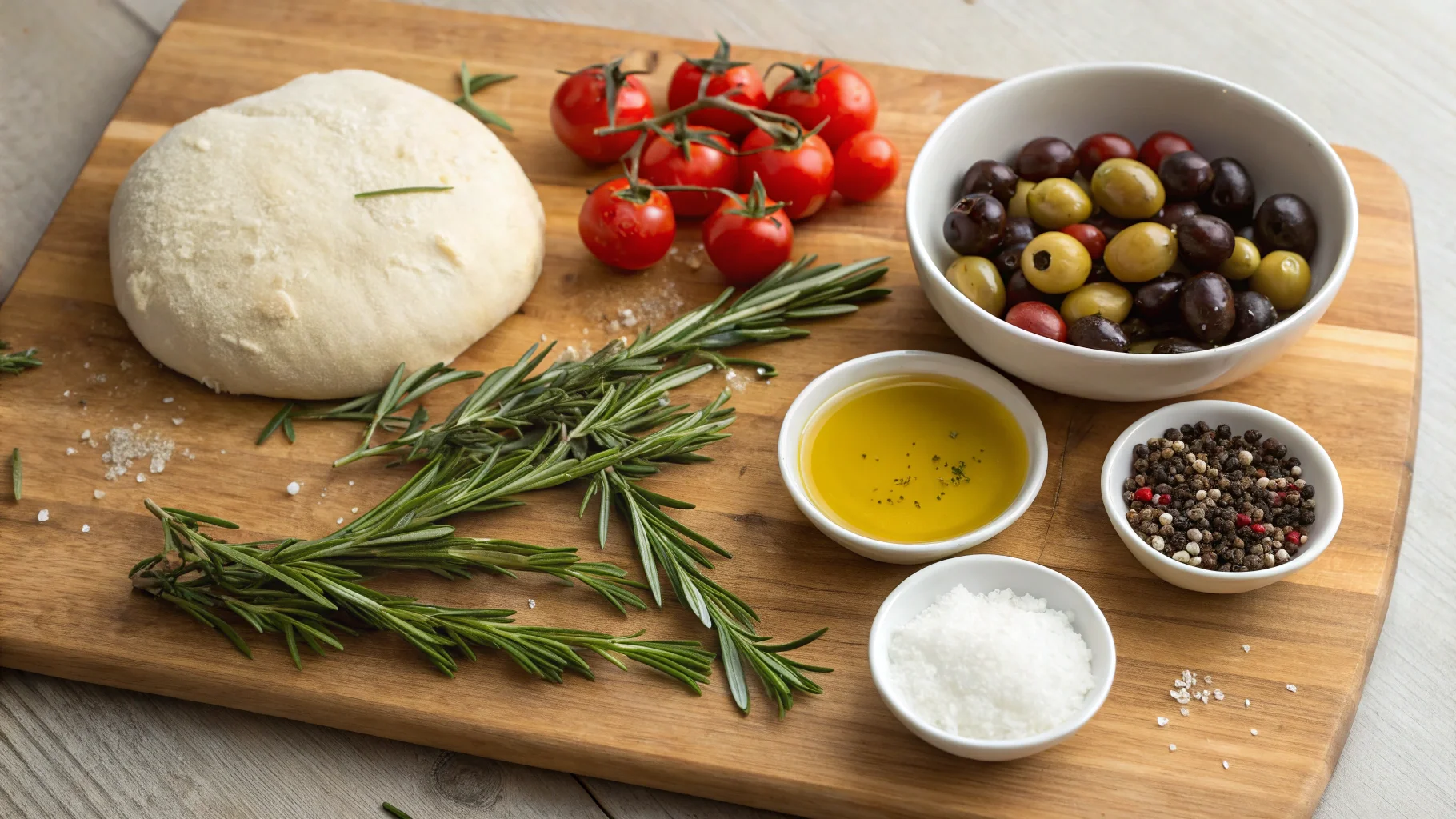
Tools and Equipment You’ll Need
The right tools can make a significant difference in the quality of your homemade pizza dough focaccia. To achievethe best results, it’s crucial to have the necessary baking tools and equipment.
Essential Baking Tools
To start, you’ll need some basic baking tools that are essential for making pizza dough focaccia. These include:
- A large mixing bowl for combining ingredients
- A measuring scale for accurate measurements
- A wooden spoon or dough whisk for mixing
- A baking sheet or pizza stone for baking
- Oven mitts for safe handling of hot baking sheets
These essential baking tools will help you prepare and bake your focaccia with ease.
Optional Equipment for Better Results
While not necessary, some optional equipment can enhance your baking experience and improve the quality of your focaccia. Consider investing in:
- A stand mixer with a dough hook attachment for easier kneading
- A dough scraper for handling sticky dough
- A baking steel for a crispy crust
- A pastry brush for applying olive oil
These tools can help you achieve a more professional finish and make the baking process more efficient.
My Easy Pizza Dough Focaccia Recipe
Transforming pizza dough into focaccia is a straightforward process that yields impressive results. I’ve been making focaccia using pizza dough for years, and I’m excited to share this simple recipe with you.
Ingredient Measurements and Prep
To make this delicious focaccia, you’ll need the following ingredients:
| Ingredient | Quantity |
| Pizza dough | 1 lb |
| Olive oil | 1/4 cup |
| Rosemary leaves | 2 tbsp |
| Coarse sea salt | 1 tsp |
Ensure your pizza dough is at room temperature before starting. If you’ve stored it in the refrigerator, let it sit out for at least an hour.
Quick vs. Slow Fermentation Options
One of the best things about this easy focaccia recipe with pizza dough is its flexibility. You can choose between a quick, same-day method or a slower overnight fermentation.
Same-Day Focaccia Method
For a quick focaccia with pizza dough, you can let the dough rise at room temperature for about an hour, or until it has doubled in size. Then, shape it into a focaccia and let it rise for another 30 minutes before baking.
Overnight Refrigeration Method
Alternatively, you can use the overnight refrigeration method for a more complex flavor. After shaping the dough into a ball, place it in the refrigerator overnight. The next day, let it come to room temperature and rise for about an hour before shaping it into focaccia and baking.
Both methods yield delicious results, so you can choose based on your schedule and preference.
Step-by-Step Preparation Process
Now that we have our ingredients ready, let’s dive into the step-by-step process of making delicious pizza dough focaccia. This process involves several key steps: mixing and kneading the dough, allowing it to rise, shaping it, and finally, creating those characteristic dimples.
Mixing and Kneading the Dough
Mixing and kneading are crucial for developing the gluten in the dough, which gives focaccia its chewy texture. There are two primary methods for mixing and kneading: the hand mixing method and using a stand mixer.
Hand Mixing Method
The hand mixing method is a great way to get a feel for the dough. Start by combining dry ingredients in a large bowl, then gradually add water and olive oil. Mix until a shaggy dough forms, then knead on a floured surface for about 10 minutes until the dough becomes smooth and elastic.
Stand Mixer Method
Using a stand mixer with a dough hook attachment can significantly reduce the kneading time. Combine ingredients in the mixer bowl and mix until just combined. Then, knead for about 5-7 minutes until the dough is smooth and elastic.
First Rise and Shaping
After kneading, place the dough in a lightly oiled bowl, cover it, and let it rise in a warm, draft-free area until it has doubled in size. Once risen, gently deflate the dough and transfer it to a baking sheet lined with parchment paper. Shape it into a rectangle or circle, depending on your preference.
Creating the Classic Focaccia Dimples
To create the characteristic dimples, use your fingers to gently press into the dough, making sure not to puncture it. Drizzle with olive oil and sprinkle with your choice of toppings, such as rosemary or sea salt.
By following these steps, you’ll be able to create a delicious homemade focaccia that’s perfect for dipping or serving alongside your favorite dishes.
Baking Your Pizza Dough Focaccia to Perfection
To achieve the perfect crust on your pizza dough focaccia, you’ll need to master a few key baking steps. Baking focaccia is not just about throwing the dough in the oven; it’s about creating that ideal balance of crunch and softness.
Oven Temperature and Positioning
Preheating your oven to the right temperature is crucial. For focaccia, a temperature of 425°F (220°C) is ideal. Ensure your oven is preheated properly before baking. Positioning is also key; place your focaccia on the middle rack to allow for even baking.
Timing and Visual Cues for Doneness
The baking time for focaccia can vary, but generally, it takes about 15-20 minutes. Keep an eye on your focaccia; it’s done when it’s golden brown and sounds hollow when tapped on the bottom. Timing is crucial, as overbaking can lead to a dry texture.
Cooling and Serving
Once baked, remove your focaccia from the oven and let it cool on a wire rack. This step is essential for maintaining the texture. Serve warm or at room temperature, depending on your preference.
| Baking Stage | Temperature | Timing |
| Preheating | 425°F (220°C) | Until preheated |
| Baking | 425°F (220°C) | 15-20 minutes |
| Cooling | Room Temperature | At least 10 minutes |
Creative Toppings and Flavor Variations
Once you’ve mastered the art of baking pizza dough focaccia, it’s time to get creative with your toppings. The beauty of homemade focaccia lies in its versatility, allowing you to experiment with a wide range of flavors and ingredients.
Classic Rosemary and Sea Salt
A timeless favorite, the combination of rosemary and sea salt is a simple yet elegant way to top your focaccia. The piney flavor of rosemary complements the savory taste of the bread, while the sea salt adds a satisfying crunch. To achieve this classic look, sprinkle coarse sea salt and fresh rosemary leaves over your focaccia before baking.
Mediterranean Inspired Toppings
The Mediterranean region is known for its rich flavors and ingredients, making it a perfect inspiration for focaccia toppings. Here are a couple of delicious variations:
Tomato and Herb
Fresh tomatoes and herbs like basil or oregano can add a burst of flavor to your focaccia. Simply top your dough with diced tomatoes and a sprinkle of chopped herbs before baking.
Olive and Feta
For a salty, savory taste, top your focaccia with a mix of olives and crumbled feta cheese. The brininess of the olives pairs perfectly with the tanginess of the feta, creating a deliciously Mediterranean flavor profile.
| Topping Combination | Flavor Profile | Recommended For |
| Rosemary and Sea Salt | Savory, Herbaceous | Those who enjoy classic flavors |
| Tomato and Herb | Fresh, Fruity | Summer gatherings or light meals |
| Olive and Feta | Salty, Tangy | for those who enjoy Mediterranean cuisine |
Sweet Focaccia Variations
While focaccia is often associated with savory toppings, it can also be a great base for sweet variations. Consider topping your focaccia with ingredients like caramelized onions, fig jam, or even cinnamon and sugar for a dessert-like treat. The key is to balance the sweetness with the savory flavor of the bread.
Experimenting with different toppings and flavors is where the real fun begins with pizza dough focaccia. Whether you’re in the mood for something classic and simple or adventurous and sweet, the possibilities are endless.
Troubleshooting Common Pizza Dough Focaccia Problems
The path to perfect focaccia involves understanding and solving common issues that may arise during preparation. Even experienced bakers encounter problems, but knowing how to troubleshoot can make all the difference.
Dough Not Rising Properly
If your dough isn’t rising as expected, check the yeast’s expiration date and ensure the water was at the right temperature. Sometimes, the issue might be with the environment; make sure it’s warm and draft-free. Overmixing can also kill the yeast’s activity, so mix your ingredients just until they come together.
Too Dense or Too Airy Texture
A dense focaccia can result from underproofing or too much flour. On the other hand, an overly airy texture might be due to overproofing. To achieve the perfect balance, monitor your dough’s proofing time closely and adjust according to the environment.
Fixing Underbaked or Overbaked Focaccia
Baking time and temperature are crucial. If your focaccia is underbaked, it might be soft and soggy in the center. Simply bake it for a few more minutes. If it’s overbaked, it could be dry; to avoid this, keep an eye on it during the baking process. Using a thermometer can help ensure your oven is at the correct temperature.
Storing and Refreshing Your Homemade Focaccia
Once you’ve baked your focaccia to perfection, it’s essential to know how to store it correctly to preserve its flavor and texture. Proper storage ensures that your homemade focaccia remains fresh and delicious for as long as possible.
Short-Term Storage Methods
For short-term storage, you can keep your focaccia at room temperature or in the refrigerator. At room temperature, it’s best to store it in a paper bag or wrapped in a clean kitchen towel to maintain its crustiness. This method is ideal for up to 2 days. If you prefer to refrigerate, wrap the focaccia tightly in plastic wrap or aluminum foil to prevent drying out. Refrigerated focaccia can last for up to 5 days.
Freezing and Reheating Tips
Freezing is an excellent way to extend the life of your homemade focaccia. There are two main methods: freezing whole loaves and freezing individual portions.
Freezing Whole Loaves
To freeze a whole loaf, wrap it tightly in plastic wrap or aluminum foil and then place it in a freezer-safe bag. This method is great for storing larger batches. When you’re ready to enjoy it, simply thaw at room temperature or reheat in the oven.
Freezing Individual Portions
For individual portions, slice the focaccia before freezing. Wrap each slice in plastic wrap and then place them in a freezer-safe bag. This method is convenient for reheating single servings. To reheat, you can toast the frozen slice directly or thaw it first and then warm it in the oven.
| Storage Method | Duration | Tips |
| Room Temperature | Up to 2 days | Store in paper bag or on clean kitchen towel. |
| Refrigerate | Up to 5 days | Wrap tightly in plastic wrap or aluminum foil. |
| Freeze Whole Loaf | Up to 3 months | Wrap tightly and place in a freezer-safe bag. |
| Freeze Individual Portions | Up to 3 months | Wrap slices individually and store in a freezer-safe bag. |
By following these storage and reheating tips, you can enjoy your homemade focaccia for a longer period while maintaining its quality and flavor.
Nutritional Benefits of Homemade Pizza Dough Focaccia
Beyond its delicious taste, homemade focaccia made from pizza dough has a range of nutritional benefits. When prepared with the right ingredients and techniques, it can be a healthier addition to your diet.
Calorie and Macronutrient Breakdown
A typical serving of homemade pizza dough focaccia (about 100g) contains approximately 250-300 calories. The macronutrient breakdown includes:
- Carbohydrates: 40-50g
- Protein: 5-7g
- Fat: 8-12g
The exact nutritional content can vary based on the type of flour used, the amount of olive oil, and any additional toppings. Using whole grain flour, for instance, can significantly increase the fiber content, making it a healthier option.
Making Healthier Focaccia Variations
To enhance the nutritional value of your focaccia, consider making a few simple adjustments to the recipe.
Whole Grain Options
Switching from all-purpose flour to whole wheat or other whole grain flours can boost the fiber and nutrient content of your focaccia. Whole grain focaccia not only provides more fiber but also contains more vitamins and minerals compared to its refined counterpart.
Reducing Oil Content
While olive oil is a key ingredient in traditional focaccia, you can reduce the amount used or substitute it with other healthier oils. Using a mixture of olive oil and other oils like avocado oil can maintain flavor while adjusting the nutritional profile.
FAQ
Can I make focaccia from pizza dough?
Yes, you can make delicious focaccia using pizza dough. The characteristics of pizza dough make it an ideal candidate for creating tasty focaccia.
Are pizza dough and focaccia dough different?
While pizza dough and traditional focaccia dough share similarities, they can differ in terms of hydration levels, oil content, and fermentation time. However, pizza dough can be used to make great focaccia.
Can you use pizza dough to make bread?
Absolutely, pizza dough can be used to make various types of bread, including focaccia. Its versatility allows for different applications beyond making pizza.
Is pizza flour good for focaccia bread?
Pizza flour, often referred to as “00” flour or caputo flour, can be used for making focaccia. However, the type of flour you choose depends on the texture and flavor you prefer. All-purpose flour or bread flour can also be used.
How to make focaccia from pizza dough?
To make focaccia from pizza dough, simply shape the dough into a flat rectangle or circle, dimple it with your fingers, and top it with your desired ingredients before baking until golden brown.
What’s the best pizza dough for focaccia?
The best pizza dough for focaccia is one that has been allowed to ferment properly, giving it a rich flavor and tender texture. You can use a homemade or store-bought pizza dough, depending on your preference.
How to make focaccia pizza?
To make focaccia pizza, top your focaccia bread with pizza sauce, cheese, and your favorite toppings, then bake until the cheese is melted and bubbly.
Is it better to make focaccia with a quick or slow fermentation?
Both quick and slow fermentation methods can produce great results. A slow fermentation can lead to a more complex flavor, while a quick fermentation is faster and still yields delicious focaccia.
Can I freeze homemade focaccia made from pizza dough?
Yes, you can freeze homemade focaccia. Simply wrap it tightly in plastic wrap or aluminum foil and store it in the freezer for up to 3 months. To reheat, thaw at room temperature or bake in the oven until crispy.
Conclusion: Why You’ll Never Go Back to Store-Bought Bread
Making homemade pizza dough focaccia is a game-changer for bread lovers. The benefits of homemade focaccia are numerous, from the control over ingredients to the joy of baking. By choosing to make your own focaccia, you’re not only opting for a healthier alternative but also experiencing the satisfaction of creating something delicious from scratch.
Homemade focaccia stands out from store-bought bread in several ways. The freshness, texture, and flavor are all superior when you make it yourself. When comparing homemade vs store-bought bread, the difference is clear: homemade focaccia is made with love and care, resulting in a more authentic taste experience. So, why is homemade focaccia better? It’s simple – the love and care put into making it make all the difference.
As you’ve learned through this article, making pizza dough focaccia at home is easier than you think. With the right ingredients, tools, and a bit of patience, you can enjoy delicious, freshly baked focaccia whenever you want. So, go ahead and give it a try – your taste buds will thank you for the delicious homemade focaccia.
Looking for more delicious recipes? Check out these amazing collections:
➡ Keep an eye on Hyper Recipes’ Facebook for the latest recipes, cooking tips, and meal suggestions.
➡Get inspiration from Pinterest to find other delicious dishes to serve with your meal.
Related Recipes You Might Love
Want to explore more side dishes? Check out these delicious recipes:
- Pizza Crunchers – A Simple Step to Delicious Homemade Pizza Crunchers.
- Chicken Pickle Pizza – A flavor-packed fusion of juicy chicken, crunchy pickles, and creamy sauce.
- Pickle Pie Pizza – A zesty twist on tradition, bursting with bold flavors.
- Fruit pizza – A light and fruity treat layered with creamy frosting and fresh seasonal fruit.
- tuna pizza – A deliciously different pizza with tender tuna and a hint of garlic and oregano.
- Anchovy pizza – A punchy, flavor-packed pizza for true anchovy lovers.
For more homemade meal ideas, visit Hyper Recipes and explore a variety of delicious dishes!
Print
How to Make the Best Pizza Dough Focaccia – Soft, Golden, and Full of Flavor
This Pizza Dough Focaccia is the perfect shortcut to a fluffy, golden Italian flatbread without making dough from scratch. It’s crispy on the outside, airy on the inside, and loaded with olive oil, herbs, and your favorite toppings. Ideal as an appetizer, sandwich bread, or a side to pasta, this fuss-free focaccia brings bakery-quality flavor right from your kitchen.
- Total Time: 35 minutes
- Yield: 1 focaccia (9×13-inch pan)
Ingredients
1 lb store-bought or homemade pizza dough (room temperature)
3 tbsp olive oil, divided
1 tsp flaky sea salt or kosher salt
1 tsp dried oregano or Italian seasoning
½ tsp garlic powder (optional)
Fresh rosemary sprigs (optional, for topping)
Cherry tomatoes or sliced olives (optional, for topping)
Instructions
Preheat your oven to 425°F (220°C). Lightly grease a 9×13-inch baking pan with 1 tablespoon of olive oil.
Place the pizza dough in the pan and stretch it gently with your fingers to fit the shape. If it resists, let it rest for 10 minutes and try again.
Cover the dough with a damp cloth and let it rest in a warm spot for 30 minutes to puff slightly.
Drizzle 2 tablespoons of olive oil over the dough. Use your fingers to dimple the surface all over—press down to create classic focaccia indents.
Sprinkle with flaky salt, dried herbs, and garlic powder if using. Add rosemary, tomatoes, or olives if desired.
Bake for 20–25 minutes, or until golden brown and crisp on the edges.
Let cool slightly before slicing and serving. Enjoy warm or at room temperature.
Notes
If using refrigerated dough, let it come to room temperature for at least 30 minutes before shaping.
Try different toppings like caramelized onions, sun-dried tomatoes, or shredded cheese.
Serve with a side of olive oil and balsamic vinegar for dipping.
- Prep Time: 10 minutes
- Cook Time: 25 minutes
- Category: Side Dish
- Method: Baking
- Cuisine: Italian
Nutrition
- Serving Size: 1 slice
- Calories: 210
- Sugar: 0.5g
- Sodium: 310mg
- Fat: 9g
- Saturated Fat: 1.5g
- Unsaturated Fat: 7g
- Trans Fat: 0g
- Carbohydrates: 26g
- Fiber: 1g
- Protein: 4g
- Cholesterol: 0mg
Keywords: easy focaccia, pizza dough focaccia, Italian flatbread, shortcut focaccia, quick bread recipe

